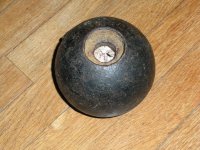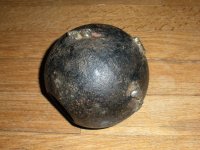19th Va Rob
Established Users
Hello; I'm new to the forum and love the info found here. I'm an avid amateur historian, and Civil War Reenactor since 1997. While I was out and about today I picked up piece I think is a 12lb case shot that probably used a borman fuse.
When I saw it I picked it up expecting a gate post ball, or a shot put or something. When I saw the open hole, it seemed to me to have a good possibility of being a "cannon ball". The opening is two staged, with both stages being threaded. It's cast iron rather than steel. I don't have a way to weigh it right now, but the circumference is right at 14 inches.
It appears that at one time someone made a tripod type stand for it by braising on some lead posts, thus displaying the fuse hole upwards on a 45 degree angle.
Inside I found old paper, and even some candy wrappers stuffed in the fuse hole.
When I saw it I picked it up expecting a gate post ball, or a shot put or something. When I saw the open hole, it seemed to me to have a good possibility of being a "cannon ball". The opening is two staged, with both stages being threaded. It's cast iron rather than steel. I don't have a way to weigh it right now, but the circumference is right at 14 inches.
It appears that at one time someone made a tripod type stand for it by braising on some lead posts, thus displaying the fuse hole upwards on a 45 degree angle.
Inside I found old paper, and even some candy wrappers stuffed in the fuse hole.




